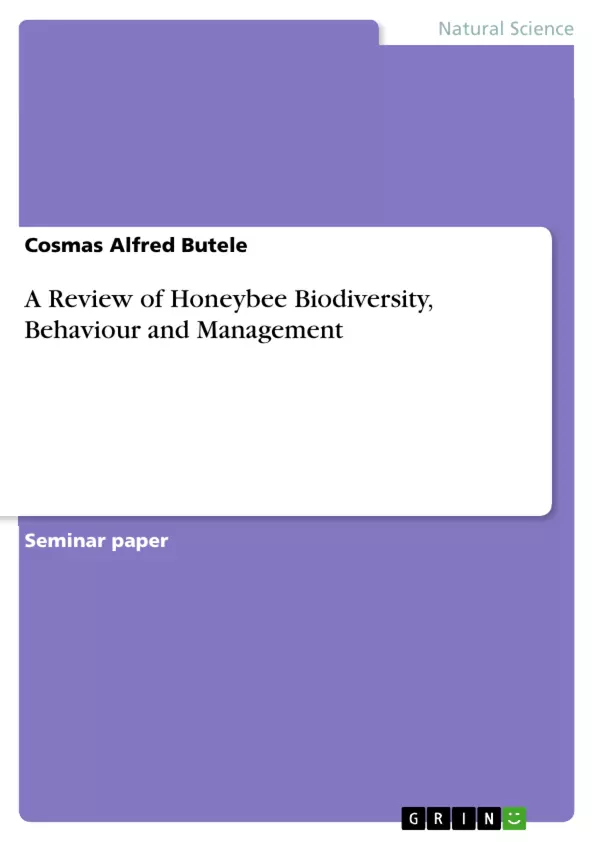Bees evolved in specific areas of the world long ago, before they spread to become
globally as they are today (Tables 1 and II), according to Kugonza (2009). As they
spread, they became adapted to the local ecological conditions of the different areas,
changing in morphology and behaviour to fit within the requirements of the ecosystem,
giving rise to a wide bee biodiversity of bee species and races we see today. Bees are
classified under Animal Kingdom, Phylum Arthropoda. They belong to Class Insecta,
which is divided into 29 Orders. Bees belong to the order Hymenoptera, which has three
Super families, namely: Apoidea (bees), Formicoidea (ants) and Vespoidea (wasps).
There are around 30,000 named species of bees (Apoidea). Apoidea is further divided
into several Families, namely Apidae (social bees), colletidae, Andrenidae, Halictidae,
Melittidae, Megachilidae, and Anthophoridae. Most of the Families have solitary
individuals: each female bee makes her own nest, lays a single egg and provides food for
the single larva that develops. However, a high level of social development is shown by
the species in Apidae where the individuals live together in a permanent, large colony,
headed by a single egg-laying queen (BfD, 2003c). Apidae is composed of four genera:
Apis (honeybees), Trigona and Melipona (stingless bees), and Bombus (bumble bees).
According to MAAIF (2012a), the genus Apis is comprised of 5 main species of honey
bees: Apis dorsata (the giant honey bee); Apis laboriosa (the darker giant honey bee);
Apis florea (the little or dwarf honey bee); Apis cerana (formerly Apis indica), is the
eastern hive honey bee; and Apis mellifera (western honey bee). These species have
evolved and differentiated into more species and races of honey bees. Kugonza (2009)
described 9 species of honey bees in the world, which Oldroyd and Wongsiri (2006)
grouped under 3 subgenera: Micrapis (Apis florea and A. andreniformis), Megapis (A.
dorsata and A. laboriosa) and Apis (A. cerana, recently recognized as separate races of
A. nigrocinta, A. koschevnikovi and A. nuluensis, and A. mellifera). Dietz (1992), Hussein
(2000) and Wikipedia (2012) described over 28 races of A. mellifera alone. Beekeeping
started with honey bees (Apis species), a practice called Apiculture, although keeping of
stingless bees, belonging to the genera Trigona and Melipona, a practice called
Meliponiculture, has recently picked up [...]
Inhaltsverzeichnis (Table of Contents)
- INTRODUCTION
- DESCRIPTION
- GENERAL ANALYSIS
- ACTUALIZATION
- DISCUSSIONS
- GENERAL RECOMMENDATIONS
- CONCLUSION
- BIBLIOGRAPHY
Zielsetzung und Themenschwerpunkte (Objectives and Key Themes)
This review delves into the fascinating world of honey bees, exploring their biodiversity, behavior, and management practices. The aim is to provide a comprehensive understanding of these vital insects, emphasizing the critical role they play in pollination and the challenges they face in the modern world.
- Honey bee biodiversity and its global distribution
- The complex social behavior of honey bees
- Key management practices for healthy bee colonies
- Threats to honey bee populations, including diseases, parasites, and pesticides
- Strategies for sustainable beekeeping and conservation
Zusammenfassung der Kapitel (Chapter Summaries)
- Introduction: This chapter sets the stage by introducing the importance of honey bees as pollinators and highlighting the challenges they face. It also provides a brief overview of the topics covered in the review.
- Description: This chapter explores the diverse world of honey bee species and races, focusing on their morphological and behavioral characteristics, as well as their geographical distribution.
- General Analysis: This chapter examines the key aspects of honey bee biology, including their social organization, communication, and foraging behavior. It also discusses the factors that influence colony health and productivity.
- Actualization: This chapter delves into practical aspects of honey bee management, covering topics such as hive types, queen rearing, and disease prevention. It also explores the role of beekeepers in ensuring the sustainability of honey bee populations.
- Discussions: This chapter provides a platform for discussing the challenges faced by honey bees, including the impacts of climate change, habitat loss, and pesticide use. It also explores various strategies for mitigating these threats and promoting honey bee conservation.
- General Recommendations: This chapter offers recommendations for improving honey bee management practices and promoting sustainable beekeeping. It also emphasizes the importance of collaborative efforts between beekeepers, researchers, and policymakers.
Schlüsselwörter (Keywords)
This review focuses on a wide range of topics related to honey bees, including bee biodiversity, social behavior, colony management, diseases, parasites, pesticides, sustainable beekeeping, and conservation efforts. Key terms that encapsulate these concepts include Apis mellifera, Apis cerana, colony collapse disorder (CCD), varroa mites, pesticides, pollinator decline, and sustainable beekeeping practices.
- Arbeit zitieren
- BSc, MS (Candidate) Cosmas Alfred Butele (Autor:in), 2012, A Review of Honeybee Biodiversity, Behaviour and Management, München, GRIN Verlag, https://www.grin.com/document/209165



